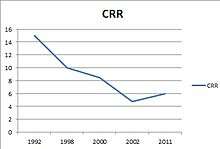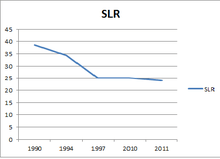Monetary policy of India
Monetary policy is the process by which monetary authority of a country, generally central bank controls the supply of money in the economy by its control over interest rates in order to maintain price stability and achieve high economic growth.[1] In India, the central monetary authority is the Reserve Bank of India (RBI). It is so designed as to maintain the price stability in the economy. Other objectives of the monetary policy of India, as stated by RBI, are:-
- Price Stability
- Price Stability implies promoting economic development with considerable emphasis on price stability. The centre of focus is to facilitate the environment which is favourable to the architecture that enables the developmental projects to run swiftly while also maintaining reasonable price stability.
- Controlled Expansion Of Bank Credit
- One of the important functions of RBI is the controlled expansion of bank credit and money supply with special attention to seasonal requirement for credit without affecting the output.
- Promotion of Fixed Investment
- The aim here is to increase the productivity of investment by restraining non essential fixed investment.
- Restriction of Inventories and stocks
- Overfilling of stocks and products becoming outdated due to excess of stock often results in sickness of the unit. To avoid this problem the central monetary authority carries out this essential function of restricting the inventories. The main objective of this policy is to avoid over-stocking and idle money in the organization.
- To Promote Efficiency
- It is another essential aspect where the central banks pay a lot of attention. It tries to increase the efficiency in the financial system and tries to incorporate structural changes such as deregulating interest rates, ease operational constraints in the credit delivery system, to introduce new money market instruments etc.
- Reducing the Rigidity
- RBI tries to bring about the flexibilities in the operations which provide a considerable autonomy. It encourages more competitive environment and diversification. It maintains its control over financial system whenever and wherever necessary to maintain the discipline and prudence in operations of the financial system.
Monetary operations
Monetary operations involve monetary techniques which operate on monetary magnitudes such as money supply, interest rates and availability of credit aimed to maintain Price Stability, Stable exchange rate, Healthy Balance of Payment, Financial stability, Economic growth. RBI, the apex institute of India which monitors and regulates the monetary policy of the country stabilizes the price by controlling Inflation. RBI takes into account the following monetary policies:
Instruments of Monetary policy
These instruments are used to control the money flow in the economy,stated following;
- Open Market Operations
- An open market operation is an instrument of monetary policy which involves buying or selling of government securities from or to the public and banks. This mechanism influences the reserve position of the banks, yield on government securities and cost of bank credit. The RBI sells government securities to control the flow of credit and buys government securities to increase credit flow. Open market operation makes bank rate policy effective and maintains stability in government securities market.

- Cash Reserve Ratio
- Cash Reserve Ratio is a certain percentage of bank deposits which banks are required to keep with RBI in the form of reserves or balances. Higher the CRR with the RBI lower will be the liquidity in the system and vice versa. RBI is empowered to vary CRR between 15 percent and 3 percent. But as per the suggestion by the Narsimham committee Report the CRR was reduced from 15% in the 1990 to 5 percent in 2002. As of 4 October 2016, the CRR is 4.00 percent.[3]

- Statutory Liquidity Ratio
- Every financial institution has to maintain a certain quantity of liquid assets with themselves at any point of time of their total time and demand liabilities. These assets have to be kept in non cash form such as G-secs precious metals, approved securities like bonds etc. The ratio of the liquid assets to time and demand assets is termed as the Statutory liquidity ratio.There was a reduction of SLR from 38.5% to 25% because of the suggestion by Narshimam Committee. The current SLR is 20.75%.[5]

- Bank Rate Policy[6]
- The bank rate, also known as the discount rate, is the rate of interest charged by the RBI for providing funds or loans to the banking system. This banking system involves commercial and co-operative banks, Industrial Development Bank of India, IFC, EXIM Bank, and other approved financial institutes. Funds are provided either through lending directly or discounting or buying money market instruments like commercial bills and treasury bills. Increase in Bank Rate increases the cost of borrowing by commercial banks which results in the reduction in credit volume to the banks and hence declines the supply of money. Increase in the bank rate is the symbol of tightening of RBI monetary policy. As of October 04, 2016 bank rate is 6.75 percent.[7]
- Credit Ceiling
- In this operation RBI issues prior information or direction that loans to the commercial banks will be given up to a certain limit. In this case commercial bank will be tight in advancing loans to the public. They will allocate loans to limited sectors. Few examples of ceiling are agriculture sector advances, priority sector lending.
- Credit Authorization Scheme
- Credit Authorization Scheme was introduced in November, 1965 when P C Bhattacharya was the chairman of RBI. Under this instrument of credit regulation RBI as per the guideline authorizes the banks to advance loans to desired sectors.[8]
- Moral Suasion
- Moral Suasion is just as a request by the RBI to the commercial banks to take so and so action and measures in so and so trend of the economy. RBI may request commercial banks not to give loans for unproductive purpose which does not add to economic growth but increases inflation.
- Repo Rate and Reverse Repo Rate
- Repo rate is the rate at which RBI lends to its clients generally against government securities. Reduction in Repo rate helps the commercial banks to get money at a cheaper rate and increase in Repo rate discourages the commercial banks to get money as the rate increases and becomes expensive. Reverse Repo rate is the rate at which RBI borrows money from the commercial banks. The increase in the Repo rate will increase the cost of borrowing and lending of the banks which will discourage the public to borrow money and will encourage them to deposit. As the rates are high the availability of credit and demand decreases resulting to decrease in inflation. This increase in Repo Rate and Reverse Repo Rate is a symbol of tightening of the policy.
Key Indicators
As of 4 October 2016, the key indicators are[9][10]
| Indicator | Current rate |
|---|---|
| Inflation | 7.5% |
| Bank rate | 6.75% [11] |
| CRR | 4.00% |
| SLR | 20.75% |
| Repo rate | 6.25% [12] |
| Reverse repo rate | 5.75% |
| Marginal Standing facility rate | 6.75%[13] |
Recently RBI signed an agreement with central government called Monetary policy framework convention on 20 Feb,2015 that puts responsibility on rbi to target maximum tolerable inflation (cpi) to achieve price stability. For the above framework rbi introduced a finance bill in Indian budget fy 2016-17 to cover statutory baking.
RBI MONETARY POLICY COMMITTEE
Recently government formed rbi policy committee viz Monetary policy committee (MPC) with six members group similar to USA fomc with 12 members. IN this 3 members from RBI and three expert members will be nominated by government. So RBI governor absolute veto is no more there with this committee but when ever there is tie i.e 3:3, Then governor can use extra vote to brake tie. Present committee targeted inflation rate is 4 percent with mean deviation of 2 percent so it stands between 2 to 6 percent.
References
| Wikimedia Commons has media related to Money of India. |
- ↑ Investopedia: Monetary Policy
- ↑ CRR DATA TAKEN FROM RBI
- ↑
- ↑ SLR Data from RBI
- ↑ https://rbidocs.rbi.org.in/rdocs/Wss/PDFs/5TB4828141FBB549A7ACE96116ED78E69C.PDF
- ↑ Bank rate data taken from RBI
- ↑
- ↑ CREDIT AUTHORIZATION SCHEME CAME INTO EXISTENCE DURING THE TENURE OF P C BHATTACHARYA
- ↑ Current Policy Rates, Reserve Ratio, Reserve Bank of India
- ↑ Key Indicators, IndiaBulls.com
- ↑ Change in Bank Rate as per RBI notification
- ↑
- ↑